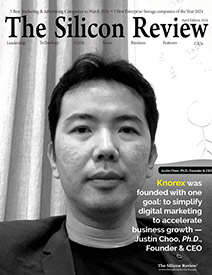50 Most Valuable Brands of The Year 2017
One Stop System’s high performance computing appliances provide a breakthrough for many HPC applications
The Silicon Review
![]()
In today’s fast moving economy, high performing technologies such as GPUs for fast data processing and flash memory for storage have emerged to handle the vast amount of data generated by satellite imagery, seismic exploration, 4k video, security and defense applications and many, many more. From this came the demand for higher and higher performing equipment to meet data processing and storage requirements. One Stop Systems (OSS) is a leader in high performance computing systems. With the creation of GPUs came the need for systems that employ large numbers of these devices.
One Stop Systems’ platforms of high-density, next generation GPUs and flash devices allow servers to access large numbers of these boards in a single chassis. In addition, systems can be clustered together to provide even greater processing and storage capabilities. HPC developers can therefore process large data sets much quicker and store and retrieve them at lightning speeds. The following are a few HPC applications using OSS’ platforms..
The defense industry is one that has taken advantage of these technological breakthroughs. GPUs are well suited for radar simulation so it makes sense that government agencies and the military are running GPU systems such as One Stop Systems’ High Density Compute Accelerator (HDCA). The HDCA supports up to sixteen NVIDIA Tesla GPUs, each with a 128Gb/s bandwidth and can be attached to up to four computers with each GPU operating at full capacity. One Stop Systems also offers a different power density option for applications that require mobile installations.
In addition to GPU accelerator solutions, the military is also using high density solid state flash systems to collect and store vast amounts of data at blazing speeds. The military utilizes aircraft that conduct anti-submarine warfare, an application that is heavily dependent on sensor technology. The various sensors aboard these aircraft all collect large amounts of data at high speeds that need to be stored. Originally, the storage systems on these crafts used outdated rotating mechanical disk storage technology that weighed hundreds of pounds and were not reliable due to vibration and human handling. On the ground, the weight of systems is less important but on an aircraft, every pound can decrease fuel. One Stop Systems was awarded contracts to design and build an incredibly dense, lightweight, high-speed, high-capacity solid state solution: the 4U Rugged Flash Storage Network Appliance (FSAn-4R). The FSAn-4R provides a quantum leap in performance and application flexibility. It uses the highest performance PCIe NVMe flash with PCIe 3.0 x8 lanes for double the bandwidth of traditional 2.5” form factor NVMe boards.
Applications such as machine learning and deep learning require incredible compute power to provide artificial intelligence for self-driving cars, climate prediction, drugs that treat today’s worst diseases, plus other solutions to more of our world’s most important challenges. There is a multitude of ways to increase compute power but one of the easiest is to use the most powerful GPUs. The NVIDIA Tesla P100 is the most advanced data center accelerator ever built. The Tesla P100 features NVIDIA NVLink™ technology that enables superior strong-scaling performance for high performance computing (HPC) and hyperscale applications. Up to eight Tesla P100 GPUs interconnected in a single node can deliver the performance of racks of commodity CPU-based servers.
Many industries deploy graphics-intensive applications on single user workstations with individual GPU resources. For those who have switched to a virtualization based environment, many of the legacy desktop virtualization platforms can’t support high end GPUs or multiple GPU configurations. Together with partners like Cisco and One Stop Systems, a London-based tech start-up ebb3 has created the High Performance Virtual Computer (HPVC) to tackle this issue with the aim of creating the fastest performing solution in the world. A key component in the infrastructure of the HPVC, Cisco’s Unified Computing System (UCS) provides a foundation for virtualized graphics workstation deployment. One Stop Systems’ GPU acceleration appliance, the ExpressBox 3600 (EB3600) integrates into ebb3’s HPVC. The EB3600 provides exceptional server and workstation grade GPUs and other HPC peripheral expansion beyond what existing host computer systems can deploy inside the workstation today. Designed to support full Gen 3x16 PCIe connectivity to all devices, the EB3600 supports up to 512 Gbps communication between the host and peripherals. The HPVC utilizes the EB3600 with four NVIDIA GRID M60 8GB graphics cards for scalable optimum performance. NVIDIA GRID technology allows a virtual desktop to access a dedicated GPU or virtualized GPU depending on the requirements of the specific application.
Advancements in video technology have slowly pushed applications like video editing, video rendering and video storage editing into the High Performance Computing world. During post production, the raw footage needs to be rendered or edited, which can be done with a variety of GPU accelerated applications. With traditional video storage, the data is stored on SSDs and transferred from PCIe RAID controllers via SATA or SAS back to PCIe for the GPUs, creating a bottleneck during the transfer. PCIe flash is the better memory option rather than traditional SSDs because the data is being transferred across the PCIe bus eliminating the bottleneck. The OSS Flash Storage Array (FSA) offers up to 200TB of fast flash storage, which allows plenty of capacity for hundreds of hours of raw 4K footage and the vast amounts of edited or rendered footage as well. In addition, because the flash is PCIe based the rendering and editing programs can access the stored footage much more quickly than SATA/SAS SSDs.
In education, a large university might have thousands of users in a virtual environment with a large percentage of those users needing access to graphics-intensive applications. The Virtual Desktop Infrastructure (VDI) infrastructure would then need multiple GPUs to handle the demand. While there are many different infrastructure options available, One Stop systems can offer one of the densest solutions with the GPUltima. One node of the GPUltima can provide 16 GPUs to share amongst a large number of users in a VDI environment.
Roll out the Red carpet for the founders
Steve Cooper, Co-founder, President, and CEO of One Stop Systems, has led the company through the upheaval of two recessions to become a leading supplier of high performance compute systems. Steve’s background includes engineering, sales and marketing and executive management with Intel, RadiSys, I-Bus and SBS Technologies. Cooper holds a BSEE degree from the University of California, Santa Barbara.
Mark Gunn, Co-founder and Sr. Vice President of One Stop Systems, has led the sales, marketing, and business development of the company. Mark’s background includes engineering design, technical writing, marketing, sales, and business development with Andros Analyzers, Computer Operated Processing Equipment Corp, Sunquest Systems, I-Bus Technologies, and SBS Technologies.









